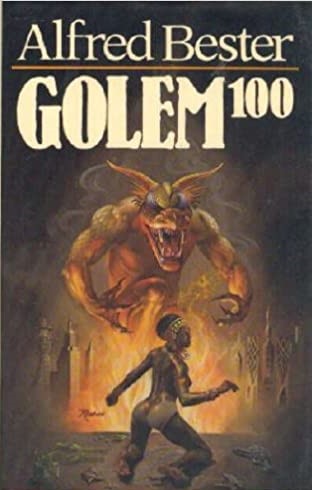 By ALFRED BESTER (Simon and Schuster; 1980)
By ALFRED BESTER (Simon and Schuster; 1980)
The most controversial of the late Alfred Bester’s novels. Bester’s fifties-era classics THE DEMOLISHED MAN and THE STARS MY DESTINATION are among the most brilliant and innovative examples of speculative fiction ever written, and with GOLEM100 he was aiming for a similar level of innovation. It’s packaged as science fiction but is actually a hallucinatory horror fest with futuristic trappings. Some readers feel it’s a postmodern masterpiece, others a self-indulgent mess; I’ll have to side with the latter view, although there are mitigating elements.
Bester’s supple, playful prose is like nothing else in sci fi or horror fiction, and helps keep the pages turning even when the book is at its most irritatingly pretentious. Bester also introduces quite a few concepts that would become major touchstones in speculative literature, including an alternate reality called the Phasmaworld (essentially an early manifestation of cyberspace) and extensive illustrations that often mesh with the text, making this one of the first true graphic novels.
It begins with a group of well-to-do “bee ladies” living in a future New York City. One day, out of boredom, the bee ladies decide to invoke the Devil. What they (inadvertently) conjure is an entity called the Golem100, a manifestation of the ladies’ darkest impulses so named because it can take on 100 different forms. Unbeknownst to the bee ladies, the creature embarks on a rape and killing rampage. It’s up to Blaise Shima, a chemist, and Gretchen Nunn, a psychic woman, to track down and take on the Golem100 in the Phasmaworld.
A simple enough premise, but it’s filtered through a tortured morass of pretension. Among the many annoyances are graphs, geometric formulae, various made-up syntaxes the characters break into without notice, innumerable stylistic quirks (as if to remind us that he was once a radio and TV scribe, Bester at one point writes in screenplay form) and the graphic art, which as rendered by the veteran illustrator Jack Gaughan often resembles childish inkblots.
And yet every time GOLEM100 seems about to collapse into unreadable nonsense it has a way of pulling itself back from the abyss, usually because of some imaginative plot twist (such as the revelation of what the protagonists were up to in the here-and-now during their initial trip into the Phasmaworld, or the Golem100’s unexpected final incarnation). Alfred Bester could be irritating, confusing and off-putting on occasion (or, on this occasion, all of the above), but he was incapable, it seems, of writing a completely uninteresting novel.
